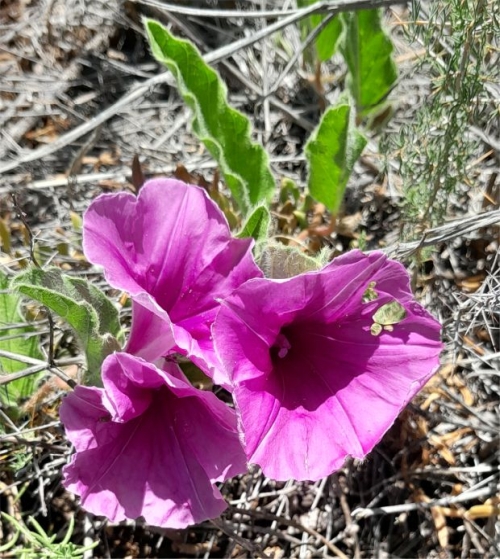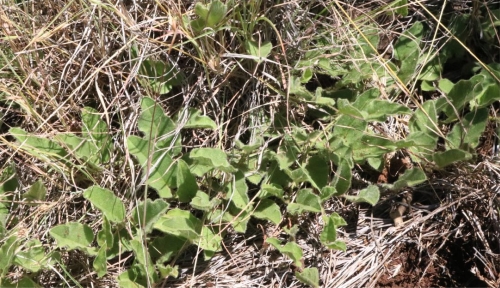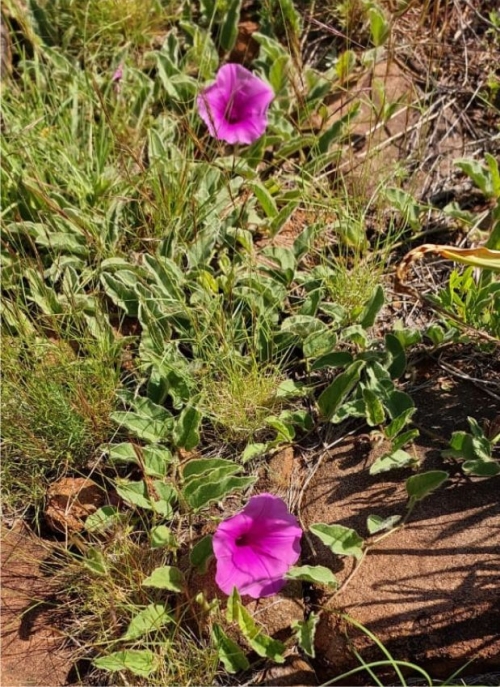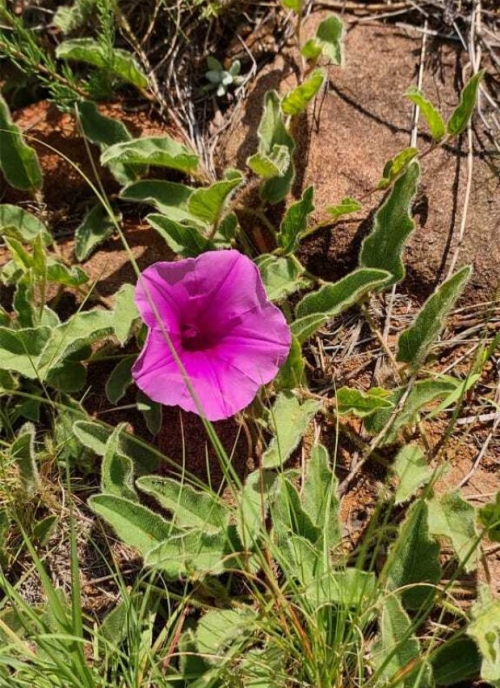Ipomoea oblongata
Ipomoea oblongata E.Mey. ex Choisy
Family: Convolvulaceae
Common names: wild morning glory, Boqo morning glory (Eng); krismisblom (Afr); ubhoqo (isiZulu); mothokgo (Sesotho)
Introduction
An exquisite creeper belonging to the morning glory family, with long stems stretched out flat on the ground, and bright, dark mauve, eye-catching flowers in summer, Ipomoea oblongata is impossible to ignore.

Description
Description
Ipomoea oblongata is a perennial herb with tuberous roots that grow up to 1 m long, and annual stems that grow up to 2 m long. It is usually woody and perennial at the base, but remaining herbaceous above. The leaf blades vary in size and shape, they are usually oblong or elliptic. Both surfaces of the leaf are hairy. The dark mauve, trumpet-like flowers, 30-70 mm long, are produced during summer, between October and April. They are short lived. The fruit is a globose, 1-3 seeded capsule, with a leathery, indehiscent wall.

Conservation Status
Status
According to the Red List of South African plants, Ipomoea oblongata is not threatened, it is assessed as Least Concern (LC).
Distribution and habitat
Distribution description
Ipomoea oblongata is widely spread in the southern African countries of Namibia, Botswana, Zimbabwe, Malawi, Eswatini, Lesotho, Mozambique and South Africa. In South Africa, it is found in all of the provinces except the Western Cape. Its natural habitat is in bushveld, savanna and grassland, where it is often seen on wet and sandy soils and it is sometimes regarded as a weed.

Derivation of name and historical aspects
History
The name Ipomoea is derived from two Greek words, ips meaning ‘worm’ or ‘bindweed’ and homoios meaning ‘like’, referring to the creeping and twining habit typical of plants of the genus. The species name oblongata means ‘oblong shaped’ or ‘oval’, like the leaves.
The genus has more than 500 species, occurring in tropical and subtropical regions of the world. About 49 species are indigenous to South Africa. Many of the species have the common name of morning glory.

Ecology
Ecology
The bright mauve flowers of Ipomoea oblongata attract birds, and insects such as ants and bees, that pollinate the flowers. Some beetles, and caterpillars of the order Lepidoptera, feed on species of Ipomoea.
Uses
Use
Ipomoea oblongata is a well-known plant because of its therapeutic uses. Most parts of the plant are used traditionally by different cultural groups to treat different illnesses. It has been reported that in Lesotho and the Free State, the roots are used to treat swollen feet, STI, diarrhoea and inflammatory diseases. The tuber is reported to be edible and the leaves can be dried and mixed with tobacco and used as snuff. In South Africa, Swati people in Mpumalanga use the roots to treat people that are diagnosed with both asthma and hypertension. The plant is also used as a charm against thunder storms, lighting and hail. Recent studies show that the antioxidant activity and bioactive compounds in extracts of this species support its uses as traditional medicine.

Growing Ipomoea oblongata
Grow
Ipomoea oblongata can be propagated through cuttings and seeds. Rooting of the cuttings can be stimulated by application of a rooting hormone and do not allow the cuttings to dry out. Plant it in full sun or semi shade in a well-drained soil. Allow the plants to remain dry during the winter dormant season.
References
- Clarke, H. & Charters, M. 2016. The illustrated dictionary of southern African plant names. Flora & Fauna Publications Trust, Jacana, Johannesburg.
- Fabian, A. & Germishuizen, G. 1997. Wild flowers of northern South Africa. Fernwood Press, Vlaeberg.
- Foden, W. & Potter, L. 2005. Ipomoea oblongata E.Mey. ex Choisy. National Assessment: Red List of South African Plants version 2020.1. Accessed on 2022/10/14.
- Meira, M., Pereira da Silva, E., David, J.M., & David, J.P. 2012. Review of the genus Ipomoea: traditional uses, chemistry and biological activities. Brazilian Journal of Pharmacognosy 22(3):682–713.
- Moffett, R. 2010. Sesotho plant and animal names and plants used by the Basotho. Sun Press, Bloemfontein.
- Moteetee, A. 2016. A review of plants used for magic by Basotho people in comparison with other cultural groups in southern Africa. Indian Journal of Traditional Knowledge 16(20):229-234
- Polori, K.L. 2014. The medicinal properties of Ipomoea oblongata E.Mey. ex Choisy. Dissertation submitted for Master in Technology: Biomedical Technology. Central University Of Technology, Free State.
- Polori, K.L., Mashele, S.S., Madamombe-Manduna, I. & Semenya, S.S. 2018. Ethno-medical botany and some biological activities of Ipomoea oblongata collected in the Free State Province, South Africa. Journal of Biological Sciences 18(8):441-449.
- Van Wyk, B. & Malan, S. 1998. Field guide to the wild flowers of the Highveld. Struik, Cape Town.
- Van Wyk, B. 2015. Pocket guide: Wild flowers of South Africa. Struik Nature, Cape Town.
Credits
Lufuno Nenungwi & Bontle Matetoane
Free State National Botanical Garden
March 2023
Plant Attributes:
Plant Type: Ground Cover, Perennial
SA Distribution: Eastern Cape, Free State, Gauteng, KwaZulu-Natal, Limpopo, Mpumalanga, North West, Northern Cape
Soil type: Sandy, Loam
Flowering season: Early Summer, Late Summer
PH: Acid, Neutral
Flower colour: Pink
Aspect: Full Sun
Gardening skill: Easy
Special Features:
Horticultural zones








Rate this article
Article well written and informative
Rate this plant
Is this an interesting plant?
Login to add your Comment
Back to topNot registered yet? Click here to register.